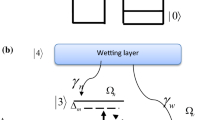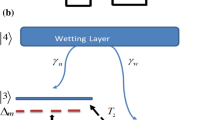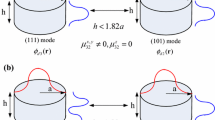Abstract
Electromagnetically induced grating (EIG) in the ladder-plus-Y double quantum dot system is modeled and the diffraction grating properties are explored in this structure. A high transmission function is obtained under the high pump field. This function is reduced under increasing the probe field due to the Kerr effect. The phase of this function depends on pumping. It is shown that the application of another two fields from the wetting layer (WL)-quantum dot (QD) type is more efficient in obtaining very high diffraction intensity. So, EIG with high diffraction intensity is obtained under a four-field application. Note that, WL-QD field effect is not studied earlier. Neglecting the WL effect reduces the transmission by five times. The diffraction intensity of this system is six times higher than that obtained from a single QD structure.













Similar content being viewed by others
References
Abdullah, M., Mohammed Noori, F.T., Al-Khursan, A.H.: Terahertz emission in ladder plus Y-configurations in double quantum dot structure. Appl. Opt. 54, 5168–5192 (2015)
Al-Ameri, H.H., Abdullah, M., Al-Khursan, A.H.: Entanglement in ladder-plus-Y-double quantum dot structure via entropy. Appl. Opt. 58, 369–382 (2019)
Al Husseini, H.B., Al Naimee, K.A., Al-Khursan, A.H., Khedir, A.H.: External modes in quantum dot light emitting diode with filtered optical feedback. J. Appl. Phys. 119, 224301 (2016)
Al-Nashy, B., Amin, S.M.M., Al-Khursan, A.H.: Kerr effect in Y-configuration double-quantum-dot system. J. Opt. Soc. Am. B 31, 1991–1996 (2014)
Asada, M., Kameyama, A., Suematsu, Y.: Gain and intervalence bans absorption in quantum-well lasers. J. Quantum Electron. 20, 745–753 (1984)
Ba, N., Wang, L., Wu, X.-Y., Liu, X.-J., Wang, H.-H., Cui, C.-L., Li, A.-J.: Electromagnetically induced grating based on the giant Kerr nonlinearity controlled by spontaneously generated coherence. Appl. Opt. 52, 4264–4272 (2013)
Brown, A.W., Xiao, M.: All-optical switching and routing based on an electromagnetically induced absorption grating. Opt. Lett. 30, 699–701 (2005)
Cheng, G., Zhong, W., Chen, A.: Phonon induced phase grating in quantum dot system. Opt. Express 23, 9870–9880 (2015)
Gue, Y., Li, J.Y., Liu, M.: Electromagnetically induced grating via coherently driven four-level atoms in a N-type configuration. Int. J. Theor. Phys. 54, 868–876 (2015)
Kamil, N.A., AL-Khursan, A.H.: Optical multistability in double quantum dot system: effect of momentum matrix elements. Superlattices Microstruct 109, 58–70 (2017)
Kazarinov, R.F., Henry, C.H., Logan, R.A.: Longitudinal mode selfstabilization in semiconductor lasers. J. Appl. Phys. 53, 4631–4644 (1982)
Kim, J., Chuang, S.L.: Theoretical and experimental study of optical gain, refractive index change, and line width enhancement factor of p-doped quantum-dot lasers. IEEE J. Quantum Electron. 42, 942–952 (2006)
Kuang, S.Q., Jin, C.S., Li, C.: Gain-phase grating based on spatial modulation of active Raman gain in cold atoms. Phys. Rev. A 84, 033831 (2011)
Ling, H.Y., Li, Y.Q., Xiao, M.: Electromagnetically induced grating: homogeneously broadened medium. Phys. Rev. A 57, 1338–1344 (1998)
Mandel, L., Wolf, E.: Optical Coherence and Quantum Optical. Cambridge University Press, Cambridge (1995)
Naseri, T., Sadighi-Bonabi, R.: Efficient electromagnetically induced phase grating via quantum interference in a four-level N-type atomic system. J. Opt. Soc. Am. B 31, 2430–2437 (2014)
Sadighi-Bonabi, R., Naseri, T.: Theoretical investigation of electromagnetically induced phase grating in RF-driven cascade-type atomic systems. Appl. Opt. 54, 3484–3490 (2015)
Sadighi-Bonabi, R., Naseri, T., Navadeh-Toupchi, M.: Electromagnetically induced grating in the microwave driven four-level atomic systems. Appl. Opt. 54, 368–376 (2015)
Sun, Y., Ding, Z., Xiao, J.: Temperature effect on first excited state energy and transition frequency of a strong-coupling polaron in a symmetry RbCl quantum dot. Phys. B 444, 103–105 (2014)
Vafafard, A., Mahmoudi, M.: Switching from electromagnetically induced absorption grating to electromagnetically induced phase grating in a closed-loop atomic system. Appl. Opt. 54, 10613–10617 (2015)
Villas-Bôas, J.M., Govorov, A.O., Ulloa, S.E.: Coherent control of tunneling in a quantum dot molecule. Phys. Rev. B 69, 125342 (2004)
Xiao, J.: Temperature and hydrogen-like impurity effects on the excited state of the strong coupling bound polaron in a CsI quantum pseudodot. Chin. Phys. B 26, 027104 (2017)
Zhai, P.W., Su, X.M., Gao, J.Y.: Optical bistability in electromagnetically induced grating. Phys. Lett. A 289, 27–33 (2001)
Zhou, F., Qi, Y., Sun, H., Chen, D., Yang, J., Niu, Y., Gong, S.: Electromagnetically induced grating in asymmetric quantum wells via Fano interference. Opt. Express 21, 12249–12259 (2013)
Author information
Authors and Affiliations
Corresponding author
Ethics declarations
Conflict of interest
The authors declare no conflict of interest.
Additional information
Publisher's Note
Springer Nature remains neutral with regard to jurisdictional claims in published maps and institutional affiliations.
Appendices
Appendix 1: Ladder-plus-Y type DQD structure
The ladder-plus-Y DQD system used in this work, see Fig. 1, has two subsystems: the first one is |0〉, |2〉 and |4〉 subbands, which forms a ladder-type subsystem with the \(\left| 0 \right\rangle \to \left| 2 \right\rangle\) transition (\(\hbar w_{02}\) energy) that was driven by a weak probe field \(E_{k}\) (frequency \(w_{k}\)) with Rabi frequency (\(\varOmega_{k} = E_{k} \mu_{02} /\hbar\)). Also, we have the \(\left| 2 \right\rangle \to \left| 4 \right\rangle\) transition (\(\hbar w_{24}\) energy) due to the coupling field \(E_{w}\), with Rabi frequency (\(\varOmega_{w} = E_{w} \mu_{24} /\hbar\)) which gives QD-WL coupling. The second subsystem contains |0〉, |1〉, |2〉, |3〉 and |4〉 subbands, which form a Y-type subsystem with the three tunneling component \(T_{0}\), \(T_{1}\) and \(T_{2}\) between \(\left| 0 \right\rangle \to \left| 1 \right\rangle\), \(\left| 1 \right\rangle \to \left| 2 \right\rangle\), and \(\left| 2 \right\rangle \to \left| 3 \right\rangle\) transitions. Also, we have the \(\left| 1 \right\rangle \to \left| 3 \right\rangle\) transition (\(\hbar w_{13}\) energy) due to the probe field \(E_{m}\) with Rabi frequency (\(\Omega _{m}\)). There is another transition coupling between QD-WL which is the \(\left| 3 \right\rangle \to \left| 4 \right\rangle\) transitions (\(\hbar w_{34}\) energy) due to the strong coupling field \(E_{n}\) with Rabi frequency (\(\Omega _{n} = E_{n} \mu_{34} /\hbar\)).
Appendix 2: The Hamiltonian of the ladder-plus-Y DQD system
The dynamical equation of the density matrix for the atomic systems can be written as (Kazarinov et al. 1982),
\(\rho\) is the density matrix operator and \((\rho^{ \cdot } = d\rho /dt)\). For the ladder-plus-Y configuration in Fig. 1, the unperturbed Hamiltonian \(H_{0}\) is diagonal in \(\left| i \right\rangle \,,\,\,(i = 0,\,\,1,\,2,\,\,3,\,\,4)\) states and results in \(w_{i}\) frequency which is the central transition frequency, i.e.
In Eq. (9), \(H_{relax}\) is the relaxation Hamiltonian which takes into account the relaxations that result from scattering processes. They are represented by \(\gamma_{r} ,(r = k,m,w,n,0,2)\) where \(\gamma_{k} ,\gamma_{m}\) are the relaxation rates from \(\left| 2 \right\rangle\) to \(\left| 0 \right\rangle\) and \(\left| 3 \right\rangle\) to \(\left| 1 \right\rangle\), \(\gamma_{w} ,\gamma_{n}\) are from WL to states \(\left| 2 \right\rangle\) and \(\left\langle 3 \right|\), while \(\gamma_{0} ,\gamma_{2}\) are from \(\left| 1 \right\rangle\) to \(\left| 0 \right\rangle\) and \(\left| 3 \right\rangle\) to \(\left| 2 \right\rangle\), respectively. Its dynamical equation is written as follows (Kazarinov et al. 1982),
with \(\rho_{ij}^{(0)} ( = \rho_{ij}^{(0)} \delta_{ij} )\) is refer to the initial distribution. Note that i and j refer to the states \(\,(0,\,\,1,\,2,\,\,3,\,\,4)\).
Appendix 3: Formulation of WL-QD transition
In addition to the interdot transitions, WL-QD transitions between QD subbands and a quasi-continuum WL state at higher energy are considered. These transitions are principal in the QD simulation. In the WL, the in-plane wavefunction can be represented by plane waves multiplied by the state due to the confinement comes from the barrier of finite height in the perpendicular direction. For WL-QD transitions, orthogonality between WL-QD states is required. This situation may represent the orthogonalized plane wave (OPW) (Mandel and Wolf 1995). In the QD structure, the wave function is,
where u (r) is the periodic Bloch function. The in-plane component in the QD is described by the Bessel function of the first kind Jm (pρ) (Kim and Chuang 2006),
where Cnm is the normalization constant, p is a constant that determined from the boundary conditions at the interface between the quantum disk and the surrounding material. In the WL, the in-plane wavefunction is described by the OPWs which are constructed from WL wave functions (plane waves) in the absence of QDs. OPW is defined as (Al-Ameri et al. 2019),
where the index \(\ell\) refers to the QD state. \(\mathop \varphi \nolimits_{WL} (\vec{\rho })\) is the in-plane (x–y plane) quantum well WL wave function defined by (Asada et al. 1984),
\(\vec{k}_{\rho }\) is the in-plan WL wave vector and \(A_{{WL_{\rho } }}\) is the in-plane WL normalization constant. The normalization coefficient in Eq. (14) is defined as (Al-Ameri et al. 2019)
Appendix 4: Single QD system
Taking the right QD, only, as a single QD system. In this case, only \(\left| 0 \right\rangle ,\,\,\left| 2 \right\rangle ,\,\,\left| 4 \right\rangle\) states are considered in the simulation, see Fig. 14. Then, the system in Eq. (4) is reduced from \(5 \times 5\) into \(3 \times 3\) matrix. The dynamical equations for the DQD system, in Eq. (5), are reduced into six equations, for the single QD system. They are:
with the condition
Rights and permissions
About this article
Cite this article
Al-Salihi, F.R., Al-Khursan, A.H. Electromagnetically induced grating in double quantum dot system. Opt Quant Electron 52, 185 (2020). https://doi.org/10.1007/s11082-020-02309-5
Received:
Accepted:
Published:
DOI: https://doi.org/10.1007/s11082-020-02309-5





